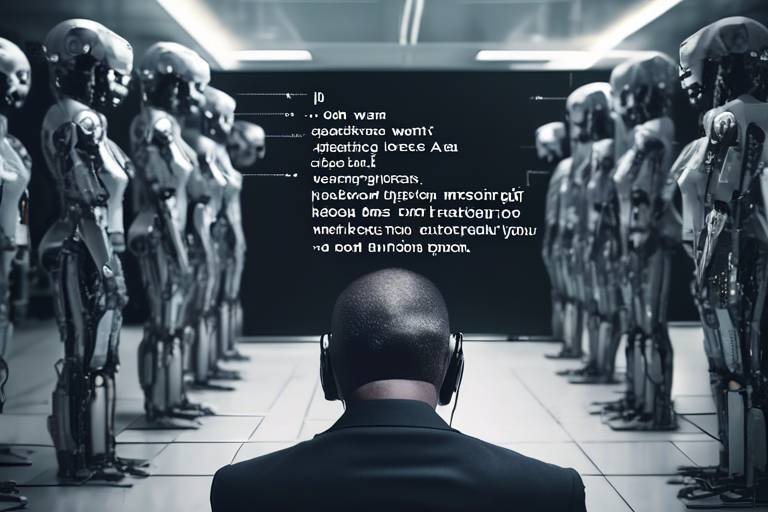Balancing Act: The Intersection of AI and Ethics
The rapid evolution of artificial intelligence (AI) has sparked a fascinating yet complex dialogue about its ethical implications. As we stand on the brink of a technological revolution, it's crucial to understand that every innovation carries with it a set of moral responsibilities. The intersection of AI and ethics isn't just a theoretical discussion; it's a practical necessity that affects our everyday lives. Imagine AI as a double-edged sword: it holds the potential to revolutionize industries and improve lives, but it also poses risks that could undermine our values and societal norms.
As AI systems become more integrated into decision-making processes—from hiring practices to law enforcement—questions arise about who is accountable for the outcomes. Are the developers responsible for the decisions made by their algorithms? What happens when an AI system makes a mistake? These questions underscore the importance of establishing a framework that not only promotes innovation but also safeguards ethical standards. The challenge lies in finding a balance that allows for technological advancement while ensuring that ethical considerations are not merely an afterthought.
Moreover, the ethical implications of AI extend beyond individual responsibility; they encompass broader societal impacts. For instance, consider how AI can influence public opinion through targeted advertising or misinformation. The ability of AI to analyze vast amounts of data and predict human behavior raises concerns about privacy and consent. Are we, as a society, willing to accept the trade-offs that come with enhanced convenience and efficiency? It's a delicate dance where the stakes are high, and the need for ethical guidelines is more pressing than ever.
In this article, we will explore various dimensions of the relationship between AI and ethics, including the challenges posed by bias, the necessity for transparency, and the role of regulatory frameworks. By engaging in this dialogue, we can better navigate the complexities of AI and ensure that it serves humanity rather than undermines it. The future of AI is not just about what technology can do, but also about what it should do. As we delve deeper into these topics, we will uncover the layers of responsibility that come with harnessing such powerful tools.
Understanding the ethical implications of AI is crucial as it impacts decision-making processes, privacy, and accountability. This section delves into the moral responsibilities of developers and organizations in creating AI systems.
AI systems can perpetuate existing biases, leading to unfair outcomes. This section examines the sources of bias in AI algorithms and discusses strategies for promoting fairness and equity in AI applications.
The data used to train AI models significantly influences their performance. This subheading explores how data collection practices can introduce bias and the importance of diverse representation in datasets.
Implementing techniques to mitigate bias during AI training is essential for ethical AI development. This section discusses various methods and best practices to ensure more equitable AI systems.
Evaluating the outcomes of AI systems is critical to understanding their impact. This subheading focuses on assessment techniques that can identify and address bias in AI applications.
Transparency in AI decision-making is vital for accountability. This section highlights the importance of clear communication regarding how AI systems operate and the ethical implications of their decisions.
Establishing regulatory frameworks is essential for guiding ethical AI development. This section discusses current regulations, proposed guidelines, and the role of policymakers in shaping the future of AI ethics.
Different countries approach AI regulation uniquely, reflecting diverse cultural and ethical values. This subheading examines global perspectives on AI governance and their implications for international collaboration.
Industry standards play a crucial role in promoting ethical AI practices. This section outlines best practices for organizations to adopt in their AI development processes to ensure ethical compliance.
As AI technology continues to evolve, so too will the ethical considerations surrounding it. This section speculates on future trends and the ongoing need for ethical discourse in AI development.
- What are the main ethical concerns surrounding AI? Ethical concerns include bias, accountability, privacy, and the implications of AI decision-making on society.
- How can we mitigate bias in AI systems? Strategies include diverse data representation, rigorous testing, and implementing fairness algorithms.
- Why is transparency important in AI? Transparency fosters trust and accountability, allowing users to understand how decisions are made.
- What role do policymakers play in AI ethics? Policymakers are essential in establishing regulations and guidelines that promote ethical AI development.

The Ethical Implications of AI
As we stand on the brink of an unprecedented technological revolution, the ethical implications of artificial intelligence (AI) demand our immediate attention. Why is this important? Because the decisions made by AI systems can significantly impact our lives, from healthcare to criminal justice, and even our personal privacy. The moral responsibilities of developers and organizations cannot be overstated; they are tasked with creating systems that not only function efficiently but also uphold our societal values.
Imagine a world where AI systems make decisions without any ethical compass. It could lead to outcomes that are not just unfair but potentially harmful. For instance, if an AI algorithm is used in hiring processes, it might inadvertently favor one demographic over another, perpetuating existing inequalities. This raises a crucial question: how can we ensure that the technology we create is not just smart but also just?
At the heart of this ethical dilemma lies the concept of accountability. Who is responsible when an AI system makes a mistake? Is it the developer who created the algorithm, the organization that deployed it, or the AI itself? To navigate these murky waters, it's essential to establish clear guidelines and frameworks that define the roles and responsibilities of all parties involved. This is where the intersection of ethics and technology becomes particularly fascinating.
Moreover, the implications extend beyond individual cases to the broader societal impact. AI has the potential to reshape entire industries, but without ethical considerations, we risk creating a landscape where the benefits are not evenly distributed. For example, while AI can enhance productivity and innovation, it can also lead to job displacement and economic disparity. Therefore, engaging in ethical discourse is not just a nice-to-have; it's a necessity for sustainable development.
In light of these challenges, organizations must prioritize ethical considerations in their AI development processes. This can include:
- Conducting regular audits of AI systems to assess their impact.
- Involving diverse stakeholders in the design and implementation phases.
- Establishing ethical review boards to oversee AI projects.
Ultimately, the ethical implications of AI are a multifaceted issue that requires ongoing dialogue and collaboration among technologists, ethicists, and policymakers. As we continue to innovate, we must also reflect on our values and the kind of future we want to create. The road ahead may be fraught with challenges, but with a strong ethical framework, we can harness the power of AI for the greater good.
- What are the main ethical concerns surrounding AI? The primary concerns include bias, accountability, privacy, and the potential for job displacement.
- How can organizations ensure ethical AI development? By implementing regular audits, involving diverse stakeholders, and establishing ethical review boards.
- Why is accountability important in AI? Accountability ensures that there is a clear understanding of who is responsible for the decisions made by AI systems, which is crucial for trust and transparency.

AI Bias and Fairness
In today's rapidly evolving technological landscape, the intersection of artificial intelligence and ethics has become a hot topic of discussion. One of the most pressing issues at this intersection is AI bias, which can lead to unfair outcomes that disproportionately affect certain groups. Imagine a world where your chances of getting a job or receiving a loan are influenced not by your qualifications but by the biases embedded in AI algorithms. This is not just a hypothetical scenario; it is a reality that many face today. As AI systems increasingly make decisions that impact our lives, understanding the sources and implications of bias becomes crucial.
AI bias often stems from the data used to train these systems. If the training data is skewed or lacks diversity, the AI will likely reflect those biases in its decision-making. For instance, if an AI system is trained primarily on data from one demographic, it may fail to accurately assess individuals from other backgrounds. This can lead to a cycle of injustice where certain groups are continually disadvantaged. The challenge lies in identifying and mitigating these biases before they cause harm, which requires a concerted effort from developers, organizations, and policymakers alike.
To promote fairness in AI applications, we need to adopt a multifaceted approach. Here are some key strategies:
- Diverse Data Collection: Ensuring that datasets are representative of all demographics is essential. This includes actively seeking out underrepresented groups to provide a more balanced perspective.
- Bias Audits: Regularly auditing AI systems for biases can help identify problematic areas. This involves testing AI outcomes against various demographic factors to ensure equitable treatment.
- Inclusive Design Practices: Involving a diverse group of stakeholders in the design and development of AI systems can lead to more equitable outcomes. This means not only including data scientists but also ethicists, community representatives, and end-users in the process.
Moreover, it is vital to implement methodologies that specifically address bias during the training phase of AI development. Techniques such as re-sampling, where we adjust the training data to ensure balanced representation, or adversarial training, which involves training the AI to recognize and correct its biases, can be effective. These methods not only enhance the fairness of AI systems but also build trust among users, who are increasingly concerned about how these technologies affect their lives.
Evaluating the outcomes of AI systems is another critical step in addressing bias. By employing assessment techniques that analyze the impact of AI decisions, we can identify discrepancies and work towards rectifying them. This evaluation should not be a one-time effort but rather an ongoing process, as AI systems are continually learning and evolving. By maintaining a feedback loop where outcomes are regularly assessed and adjusted, we can create a more equitable AI landscape.
In conclusion, the challenge of AI bias and fairness is not insurmountable. By fostering a culture of transparency, accountability, and inclusivity, we can pave the way for AI systems that serve everyone fairly. As we continue to innovate and integrate AI into our daily lives, it is imperative that we remain vigilant and proactive in addressing these ethical concerns.
Q: What is AI bias?
A: AI bias refers to the systematic and unfair discrimination that can occur when AI systems make decisions based on biased data or algorithms.
Q: Why is fairness in AI important?
A: Fairness in AI is crucial because biased AI systems can lead to unequal treatment of individuals, affecting opportunities in areas like employment, finance, and justice.
Q: How can we mitigate AI bias?
A: Mitigating AI bias involves using diverse datasets, conducting bias audits, and employing inclusive design practices during development.
Q: What role do developers play in ensuring ethical AI?
A: Developers are responsible for understanding the ethical implications of their work and implementing practices that promote fairness and accountability in AI systems.

Data Collection and Representation
When it comes to artificial intelligence, the phrase "garbage in, garbage out" rings particularly true. The data we use to train AI models is not just a collection of numbers and text; it’s the very foundation upon which these systems are built. If the data is biased or unrepresentative, the AI will inevitably reflect those flaws, leading to skewed results and potentially harmful outcomes. Imagine trying to bake a cake with spoiled ingredients—no matter how skilled the baker, the final product is unlikely to be anything but a disaster.
Data collection practices play a pivotal role in shaping AI outcomes. For instance, if an AI system is trained predominantly on data from a specific demographic, it may struggle to perform effectively for underrepresented groups. This issue highlights the critical importance of diverse representation in datasets. When developers overlook this aspect, they risk creating systems that perpetuate stereotypes or, worse, contribute to systemic inequalities. For example:
| Demographic Group | Representation in Training Data | Potential AI Outcome |
|---|---|---|
| Group A | 80% | High accuracy for this group |
| Group B | 10% | Low accuracy, potential bias |
| Group C | 10% | Low accuracy, potential bias |
This table illustrates how skewed representation can lead to significant discrepancies in AI performance across different demographic groups. To combat this, developers must prioritize inclusive data collection methods that reflect the diversity of the population. This can involve actively seeking out data from various sources and ensuring that all groups are adequately represented.
Moreover, it’s essential to consider the context in which data is collected. Context matters—the same data can lead to different interpretations depending on cultural, social, and economic factors. Therefore, understanding the nuances of data representation is crucial for ethical AI development. For instance, an AI trained on facial recognition data collected from predominantly light-skinned individuals may struggle to accurately identify individuals with darker skin tones. This not only raises ethical concerns but also poses real-world risks, such as wrongful accusations or misidentifications.
To sum it up, data collection and representation are not just technical details; they are fundamental ethical considerations that shape the very essence of AI systems. Developers must take a holistic approach, ensuring that their datasets are not only comprehensive but also reflective of the diverse world we live in. After all, the goal of AI should be to enhance our lives, not to reinforce existing biases and inequalities.

Mitigating Bias in AI Training
In the rapidly evolving world of artificial intelligence, mitigating bias during AI training has become a pressing concern for developers and organizations alike. The very foundation of AI systems is built on data, and if that data is flawed or biased, the outcomes can lead to significant ethical dilemmas. Imagine a world where AI systems make decisions that unfairly disadvantage certain groups of people—this is a reality that we must actively work to prevent.
To combat bias effectively, it’s essential to adopt a multi-faceted approach. First and foremost, organizations should prioritize diverse data collection. This means gathering data that represents a wide array of demographics, experiences, and perspectives. By ensuring that the training data encompasses various backgrounds, we can reduce the risk of perpetuating existing societal biases. For instance, if a facial recognition AI is trained predominantly on images of light-skinned individuals, it may struggle to accurately recognize individuals with darker skin tones, leading to unfair treatment.
Another crucial step in mitigating bias is to implement algorithmic audits. Regularly reviewing and testing AI algorithms can help identify biases that may not be immediately apparent. This process often involves using techniques such as adversarial testing, where developers intentionally challenge the AI with scenarios designed to expose weaknesses or biases. By doing so, organizations can refine their algorithms and enhance their overall fairness.
Moreover, fostering a culture of ethical awareness within AI development teams is vital. This can be achieved through training sessions focused on ethics in AI, encouraging developers to think critically about the implications of their work. When team members understand the potential consequences of biased AI, they are more likely to take proactive measures to prevent it. Collaboration with ethicists and social scientists can also provide valuable insights into the societal impacts of AI technologies.
Lastly, it’s important to establish clear accountability measures for AI systems. Organizations should be transparent about the data used in training their models and the methodologies employed to ensure fairness. This transparency not only builds trust with users but also encourages a more responsible approach to AI development. By openly sharing information about the steps taken to mitigate bias, companies can demonstrate their commitment to ethical practices.
In summary, mitigating bias in AI training is not just a technical requirement; it’s a moral imperative. By embracing diverse data collection, conducting algorithmic audits, fostering ethical awareness, and ensuring accountability, we can move towards a future where AI serves all individuals equitably. As we continue to innovate in this space, the responsibility lies with us to create systems that reflect our shared values and promote fairness across the board.
- What is AI bias? AI bias occurs when an AI system produces results that are systematically prejudiced due to erroneous assumptions in the machine learning process.
- How can organizations prevent AI bias? Organizations can prevent AI bias by ensuring diverse data collection, conducting regular audits, fostering ethical awareness, and maintaining transparency.
- Why is transparency important in AI? Transparency is crucial as it builds trust and allows users to understand how decisions are made, ensuring accountability in AI systems.
- What role does data diversity play in AI? Data diversity is essential as it helps AI systems learn from a broad spectrum of experiences, reducing the risk of biased outcomes.

Evaluating AI Outcomes
When we talk about , it’s not just about crunching numbers or analyzing data; it’s about understanding the real-world impact these systems have on our lives. Imagine you’ve built a smart assistant that helps people manage their schedules. Sounds great, right? But what happens if it starts prioritizing certain tasks based on biased data? Evaluating AI outcomes means digging deep into how these systems operate and the consequences they bring along.
To effectively evaluate AI outcomes, we need to consider several key aspects:
- Accuracy: Does the AI deliver results that are correct and reliable?
- Fairness: Are the outcomes equitable across different demographics?
- Transparency: Can users understand how decisions are made?
- Accountability: Who is responsible when things go wrong?
These factors are crucial because they directly influence public trust in AI technologies. For instance, imagine a healthcare AI that recommends treatments based on datasets that predominantly feature one demographic. If the AI is evaluated solely on accuracy, it might perform well statistically, but it could lead to harmful outcomes for underrepresented groups. This is why a holistic evaluation approach is essential.
One effective method for evaluating AI outcomes is through the use of performance metrics. These metrics can include:
| Metric | Description |
|---|---|
| Precision | The ratio of true positive results to the total predicted positives. |
| Recall | The ratio of true positive results to the total actual positives. |
| F1 Score | The harmonic mean of precision and recall, providing a balance between the two. |
These metrics help us gauge how well an AI system performs, but they should be accompanied by qualitative assessments. For example, user feedback can provide insights into the system's usability and the perceived fairness of its outcomes. This combination of quantitative and qualitative evaluation helps paint a clearer picture of AI effectiveness.
Furthermore, it’s vital to conduct regular audits of AI systems. Just like a car needs routine checks to ensure it’s safe to drive, AI systems also require periodic evaluations to ensure they are functioning as intended. This includes testing for biases that may have crept in over time due to changes in data or user behavior. By continuously monitoring AI outcomes, we can adapt and improve systems, ensuring they serve society as a whole.
In conclusion, evaluating AI outcomes is a multifaceted challenge that requires a blend of quantitative metrics and qualitative insights. It’s about more than just numbers; it’s about ensuring that AI serves as a force for good in our society. As we continue to rely on these technologies, prioritizing thorough evaluations will be essential in addressing ethical concerns and fostering public trust.
- What is the importance of evaluating AI outcomes? Evaluating AI outcomes is crucial to ensure that AI systems are accurate, fair, and accountable, thus maintaining public trust.
- How can bias be detected in AI outcomes? Bias can be detected through performance metrics, user feedback, and regular audits that assess the AI's decision-making processes.
- What role do performance metrics play in AI evaluation? Performance metrics provide a quantitative measure of how well an AI system is functioning, allowing for objective assessment.
- Can qualitative feedback influence AI development? Yes, qualitative feedback from users can highlight areas for improvement and help ensure the AI system meets the needs of diverse populations.

Transparency and Accountability
In the rapidly evolving landscape of artificial intelligence, transparency and accountability have emerged as non-negotiable pillars that underpin ethical AI development. Imagine a world where AI systems operate like black boxes, making decisions without any insight into their workings. Sounds unsettling, right? This lack of visibility can lead to a myriad of issues, from unfair treatment of individuals to unjust outcomes in critical sectors like healthcare and law enforcement. Thus, ensuring that AI systems are transparent is not just a technical challenge; it's a moral obligation.
To foster transparency, developers and organizations must prioritize clear communication about how AI systems function. This includes detailing the data used for training, the algorithms employed, and the criteria for decision-making. When stakeholders understand the “why” and “how” behind AI decisions, it not only builds trust but also enhances the credibility of the technology. For instance, consider a loan application process powered by AI. If applicants are informed about the factors influencing their credit scores and loan approvals, they are more likely to accept the outcomes, even if they are unfavorable.
Moreover, accountability goes hand in hand with transparency. Organizations must establish clear lines of responsibility for AI decisions. When an AI system makes a mistake, who is held accountable? Is it the developer, the organization, or the AI itself? This question is crucial, as it shapes how we view AI’s role in society. It’s essential to have mechanisms in place that allow for the auditing of AI systems, ensuring that they can be scrutinized and improved over time. This not only helps in identifying biases and errors but also reinforces the idea that AI systems should serve humanity, not the other way around.
One effective way to enhance accountability is through the implementation of ethical guidelines and regulatory frameworks. These frameworks can provide a structured approach to assessing AI systems, ensuring they adhere to established ethical standards. For example, organizations could adopt a set of principles that guide their AI development processes, such as:
- Fairness: Ensuring that AI systems do not discriminate against any group.
- Transparency: Making the workings of AI systems understandable to users.
- Accountability: Establishing who is responsible for AI decisions.
By adhering to these principles, organizations can not only enhance their AI systems but also foster a culture of responsibility and ethical awareness within their teams. Furthermore, engaging with stakeholders—including users, ethicists, and policymakers—can provide valuable insights into the societal impacts of AI, paving the way for more inclusive and responsible AI development.
In conclusion, as AI technology continues to advance, the demand for transparency and accountability will only grow stronger. It's not enough for AI systems to be efficient; they must also be explainable and just. By prioritizing these elements, we can ensure that AI serves as a force for good, ultimately benefiting society as a whole.
- Why is transparency important in AI? Transparency is crucial as it builds trust and allows users to understand how AI systems make decisions, leading to greater acceptance and ethical use of technology.
- How can organizations ensure accountability in AI? Organizations can ensure accountability by establishing clear lines of responsibility, implementing ethical guidelines, and conducting regular audits of AI systems.
- What role do stakeholders play in AI transparency? Stakeholders provide diverse perspectives and insights that can help shape ethical AI practices, ensuring that technology development is aligned with societal values.

Regulatory Frameworks for AI
As artificial intelligence (AI) continues to permeate various sectors of our lives, the need for robust regulatory frameworks becomes increasingly urgent. These frameworks serve as guiding principles, ensuring that AI technologies are developed and deployed responsibly, ethically, and in a manner that protects the rights of individuals. Without these regulations, the rapid advancement of AI could lead to unintended consequences, such as privacy violations, discrimination, and even safety risks. As a society, we must ask ourselves: how do we balance innovation with the need for ethical oversight?
Current regulations regarding AI are still in their infancy, often lagging behind the pace of technological advancement. However, some countries and organizations have begun to lay the groundwork for comprehensive AI governance. For example, the European Union has proposed the AI Act, which aims to classify AI systems based on their risk levels, from minimal to unacceptable. This classification will help determine the regulatory requirements for each category, ensuring that high-risk applications undergo rigorous scrutiny before deployment.
Moreover, regulatory frameworks need to be adaptable. The landscape of AI is constantly changing, driven by new discoveries and innovations. Therefore, policymakers must remain vigilant and flexible, ready to revise regulations as necessary to accommodate new developments. This adaptability is crucial in fostering an environment where innovation can thrive while still maintaining ethical standards.
Another important aspect of regulatory frameworks is the role of international collaboration. AI is a global phenomenon, and its implications transcend national borders. Countries must work together to establish common guidelines and standards that promote ethical AI development. This collaboration can take many forms, including:
- Sharing best practices and lessons learned from various regulatory approaches.
- Engaging in joint research initiatives to better understand the ethical implications of AI.
- Creating international agreements that hold organizations accountable for their AI practices.
In addition to government regulations, industry standards also play a significant role in shaping ethical AI practices. Organizations can adopt best practices that align with regulatory guidelines, ensuring that their AI systems are not only effective but also responsible. For instance, companies should implement ethical review boards to oversee AI development processes, ensuring that diverse perspectives are considered and that potential ethical issues are addressed proactively.
As we move forward, the conversation around AI regulation must include a diverse set of stakeholders, including technologists, ethicists, policymakers, and the general public. This inclusive approach will help ensure that regulatory frameworks are comprehensive and reflective of societal values. Ultimately, the goal is to create an ecosystem where AI can flourish while safeguarding the rights and dignity of all individuals.
- What are the main goals of AI regulatory frameworks?
The primary goals are to ensure ethical AI development, protect user privacy, prevent discrimination, and promote accountability among AI developers. - How do different countries approach AI regulation?
Countries vary in their regulatory approaches, with some adopting strict guidelines (like the EU) and others taking a more laissez-faire approach, reflecting their cultural and ethical values. - Why is international collaboration important in AI regulation?
AI's global nature means that its impacts cross borders; international collaboration helps create consistent standards and practices that can mitigate risks on a global scale. - What role do industry standards play in AI development?
Industry standards help organizations adopt ethical practices and ensure compliance with regulatory frameworks, fostering trust and accountability in AI systems.

Global Perspectives on AI Regulation
The landscape of AI regulation is as diverse as the cultures and values that shape it. Countries around the world are grappling with the ethical implications of artificial intelligence, and each approaches regulation from unique perspectives. For instance, the European Union has taken a proactive stance, emphasizing strict regulations to ensure that AI serves the public good. Their General Data Protection Regulation (GDPR) has set a high standard for data protection that influences AI development across the globe. The EU's proposed AI Act aims to categorize AI systems based on risk levels, establishing a framework that prioritizes human rights and ethical considerations.
On the other hand, the United States has a more fragmented approach, with various states implementing their own regulations. The federal government has been slower to adopt a comprehensive framework, often relying on industry self-regulation. This can lead to inconsistencies and gaps in accountability. For instance, while some tech giants are voluntarily adhering to ethical guidelines, there remains a significant risk of exploitation without robust regulatory oversight.
In Asia, countries like China are taking a different route, focusing on rapid innovation and deployment of AI technologies with less emphasis on ethical considerations. The Chinese government has implemented regulations to monitor and control AI applications, but these often prioritize state interests over individual rights. This creates a complex dynamic where innovation is encouraged, but ethical implications may be sidelined.
To illustrate the differences in regulatory approaches, consider the following table that summarizes key aspects of AI regulation across different regions:
| Region | Regulatory Approach | Key Regulations |
|---|---|---|
| European Union | Proactive and comprehensive | GDPR, AI Act |
| United States | Fragmented and industry-led | State-specific laws |
| China | State-controlled with rapid deployment | AI security regulations |
Moreover, the global conversation around AI regulation is evolving. International organizations, such as the United Nations and the OECD, are advocating for collaborative efforts to establish common guidelines that promote ethical AI development while fostering innovation. This highlights a growing recognition that AI does not adhere to national borders, and thus, a coordinated global response is essential.
As nations continue to navigate the complexities of AI regulation, it’s crucial for policymakers to engage in dialogue with stakeholders, including technologists, ethicists, and the public. The goal should be to create an inclusive framework that balances innovation with ethical responsibility, ensuring that the benefits of AI are realized without compromising fundamental rights.
- What is the purpose of AI regulation? AI regulation aims to ensure that AI technologies are developed and used in ways that are ethical, safe, and beneficial to society.
- How do different countries approach AI regulation? Countries vary in their approaches; for example, the EU emphasizes comprehensive regulations, while the US has a more fragmented approach.
- Why is international cooperation important in AI regulation? AI technologies operate globally, so international cooperation helps to establish consistent standards and practices that promote ethical use.

Industry Standards and Best Practices
In the rapidly evolving world of artificial intelligence, adhering to industry standards and implementing best practices is not just a recommendation but a necessity. As organizations strive to harness the power of AI, they must navigate a landscape filled with ethical dilemmas and potential pitfalls. The stakes are high, and the consequences of neglecting ethical considerations can be severe, affecting not just the organization but society as a whole.
To foster a culture of ethical AI development, organizations should embrace a framework that encompasses several key principles. These principles serve as a compass, guiding developers and stakeholders towards responsible AI practices. Some of the foundational principles include:
- Accountability: Developers and organizations must take responsibility for the outcomes of their AI systems. This means establishing clear lines of accountability and ensuring that there are mechanisms in place to address any negative consequences that arise.
- Transparency: Being open about how AI systems operate is crucial. This includes providing insights into data sources, algorithmic decision-making processes, and potential biases that may exist within the system.
- Fairness: Striving for fairness in AI applications is essential. Organizations should actively work to identify and mitigate biases in their algorithms, ensuring that all users are treated equitably.
- Privacy: Protecting user data is paramount. Organizations must implement robust data protection measures and be transparent about how user data is collected, stored, and used.
Moreover, organizations should consider adopting frameworks such as the AI Ethics Guidelines proposed by various standards organizations, which provide comprehensive guidelines to ensure ethical AI development. For instance, the ISO/IEC JTC 1/SC 42 standard focuses on AI and its implications, offering a structured approach to managing risks associated with AI technologies.
One effective way to establish these standards is through collaborative efforts. By working together, industry leaders, policymakers, and academic institutions can create a shared understanding of ethical AI practices. This collaboration can lead to the development of industry-wide standards that not only promote best practices but also enhance trust among users and stakeholders.
Furthermore, organizations should invest in ongoing education and training for their teams. As AI technologies advance, staying informed about the latest ethical considerations and technological developments is vital. Workshops, seminars, and online courses can provide valuable insights into best practices and emerging trends, equipping teams with the knowledge they need to navigate ethical challenges effectively.
In conclusion, establishing and adhering to industry standards and best practices is crucial in the quest for ethical AI development. By fostering a culture of accountability, transparency, fairness, and privacy, organizations can not only mitigate risks but also enhance their reputation and build lasting trust with users. As we move forward, the importance of these practices will only grow, shaping the future of AI and its impact on society.
Q1: Why are industry standards important for AI development?
A1: Industry standards ensure that AI systems are developed responsibly, minimizing risks and promoting ethical practices. They foster trust among users and stakeholders by providing guidelines for accountability, transparency, fairness, and privacy.
Q2: How can organizations implement best practices in AI?
A2: Organizations can implement best practices by adopting ethical frameworks, investing in team training, collaborating with industry leaders, and continuously evaluating their AI systems for biases and ethical concerns.
Q3: What role do policymakers play in AI ethics?
A3: Policymakers are crucial in shaping regulatory frameworks that guide ethical AI development. They can establish guidelines that promote responsible practices and ensure that organizations are held accountable for their AI systems.

The Future of AI and Ethics
The landscape of artificial intelligence (AI) is evolving at a breakneck pace, and with it comes a plethora of ethical considerations that we can't afford to ignore. As we look towards the future, the convergence of technology and morality raises some critical questions: How will we ensure that AI serves humanity rather than undermines it? What frameworks will guide the ethical deployment of this powerful technology? The answers are not just academic; they are essential for shaping a future where AI enhances our lives without compromising our values.
One of the most pressing issues is the need for ongoing ethical discourse. As AI systems become more integrated into our daily lives, from healthcare to transportation, the potential for ethical dilemmas increases. Imagine a world where AI makes decisions about who receives medical treatment or how criminal justice is administered. The stakes are incredibly high, and the consequences of unethical AI can be dire. Therefore, fostering a culture of open dialogue among developers, ethicists, and the public is crucial. This conversation must be inclusive, considering diverse perspectives to ensure that the technology reflects the values of all segments of society.
Moreover, the future of AI ethics will likely see a shift towards proactive governance. Instead of waiting for ethical breaches to occur, organizations and regulators will need to implement frameworks that anticipate potential issues. This could involve creating ethical guidelines that are as integral to AI development as technical specifications. For instance, organizations might adopt a “design for ethics” approach, where ethical considerations are embedded into the AI development process from the outset. By doing so, we can minimize risks and foster trust in AI systems.
In addition to governance, the role of education in AI ethics cannot be overstated. As AI continues to permeate various fields, it is vital for future professionals to be equipped with the knowledge and tools to navigate ethical challenges. Educational institutions should integrate AI ethics into their curricula, ensuring that students understand the implications of their work. This could involve case studies, simulations, and discussions that challenge students to think critically about the ethical dimensions of AI technologies.
Furthermore, as we venture into this uncharted territory, the concept of collaboration will be key. Different sectors—government, academia, and industry—must work together to establish best practices and standards for ethical AI. For example, a collaborative platform could be created to share insights, research, and strategies for addressing ethical dilemmas. This collective effort could pave the way for a more responsible and equitable AI landscape.
As we project into the future, it is also essential to consider the role of public engagement. The general public will have a significant stake in how AI technologies are developed and implemented. Engaging communities in discussions about AI ethics can lead to greater transparency and accountability. Public forums, surveys, and workshops can serve as platforms for individuals to voice their concerns, expectations, and hopes regarding AI. By involving the public in the ethical discourse, we can create AI systems that are more aligned with societal values and needs.
In summary, the future of AI and ethics is not just a matter of technology but a complex interplay of human values, societal norms, and governance. As we navigate this landscape, we must remain vigilant and proactive, ensuring that ethical considerations are at the forefront of AI development. The journey ahead will undoubtedly be challenging, but with collaboration, education, and public engagement, we can strive for a future where AI enhances our lives while upholding our ethical standards.
- What are the main ethical concerns surrounding AI? The primary concerns include bias, accountability, privacy, and the potential for misuse of AI technologies.
- How can organizations ensure ethical AI development? Organizations can implement ethical guidelines, engage in public discourse, and adopt a design-for-ethics approach in their development processes.
- Why is public engagement important in AI ethics? Public engagement fosters transparency, accountability, and ensures that AI systems align with societal values and needs.
- What role does education play in AI ethics? Education equips future professionals with the necessary knowledge and tools to navigate ethical challenges in AI technologies.
Frequently Asked Questions
- What are the ethical implications of AI?
The ethical implications of AI are vast and multifaceted. They encompass issues such as decision-making processes, privacy concerns, and accountability for actions taken by AI systems. Understanding these implications is crucial for developers and organizations to ensure responsible AI deployment.
- How can AI perpetuate bias, and what can be done about it?
AI can perpetuate bias through the data it is trained on. If the training data reflects societal biases, the AI will likely reproduce those biases in its outcomes. To combat this, it's essential to implement diverse data collection practices and employ techniques during training that mitigate bias, ensuring fairness and equity in AI applications.
- What role does transparency play in AI?
Transparency is vital in AI as it promotes accountability. When AI systems are transparent, users and stakeholders can understand how decisions are made, which fosters trust. Clear communication about the functioning and ethical implications of AI systems is essential to prevent misuse and ensure responsible use.
- Why are regulatory frameworks important for AI?
Regulatory frameworks are crucial because they provide guidelines for ethical AI development. They help ensure that AI technologies are developed and used responsibly, minimizing risks and protecting users' rights. Policymakers play a key role in shaping these frameworks to reflect societal values and needs.
- How do different countries approach AI regulation?
Countries have varying approaches to AI regulation, often influenced by their cultural and ethical values. Some may prioritize innovation and economic growth, while others focus on protecting individual rights and privacy. Understanding these global perspectives is essential for fostering international collaboration in AI governance.
- What are some best practices for ethical AI development?
Best practices for ethical AI development include ensuring diverse representation in training datasets, implementing bias mitigation techniques, maintaining transparency in decision-making, and adhering to established industry standards. Organizations should prioritize ethical considerations throughout the AI development lifecycle to promote responsible use.
- What does the future hold for AI and ethics?
The future of AI and ethics is likely to be shaped by ongoing advancements in technology and the evolving ethical landscape. As AI systems become more integrated into daily life, continuous dialogue about ethical considerations will be crucial. This includes addressing emerging challenges and ensuring that AI development aligns with societal values.



















